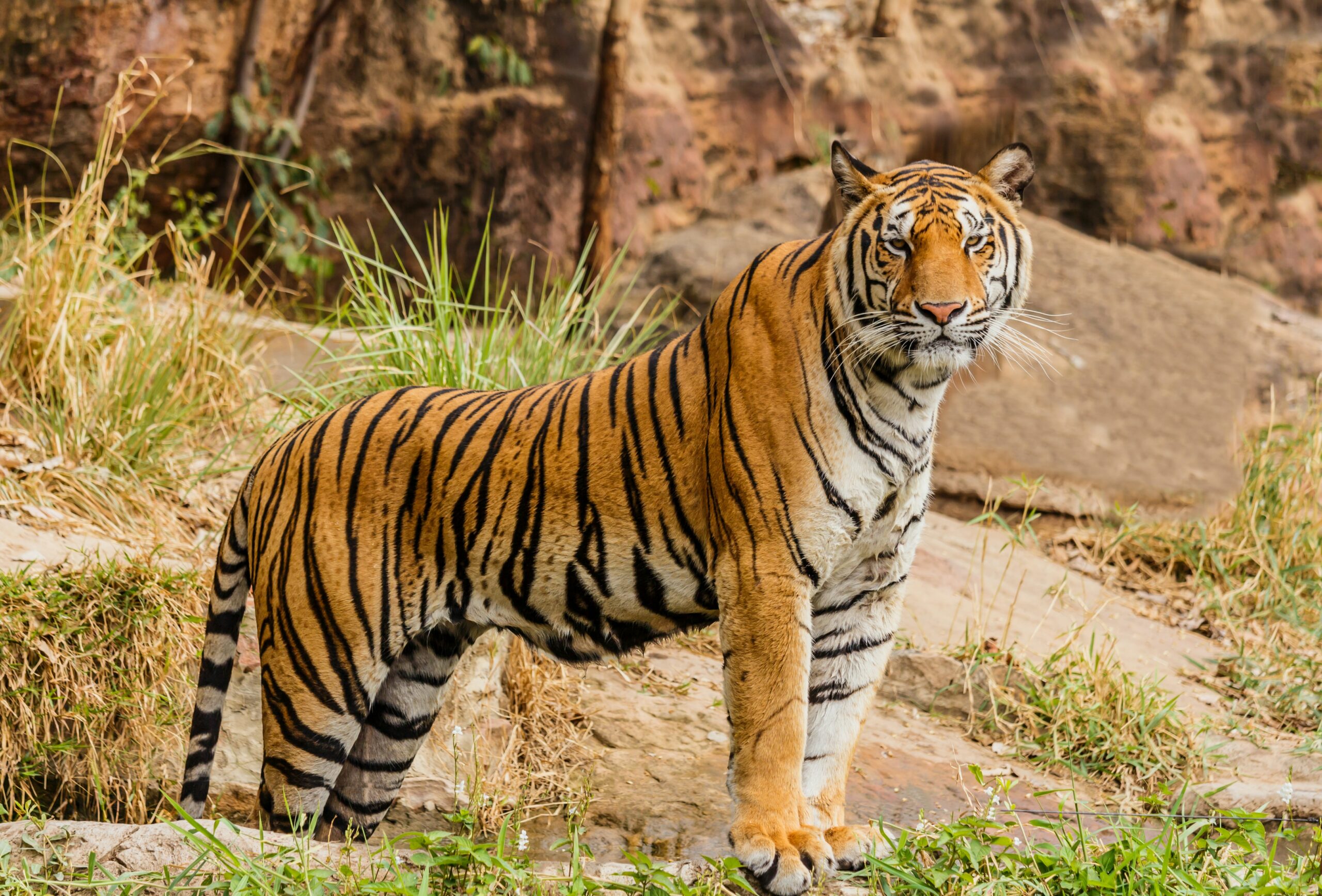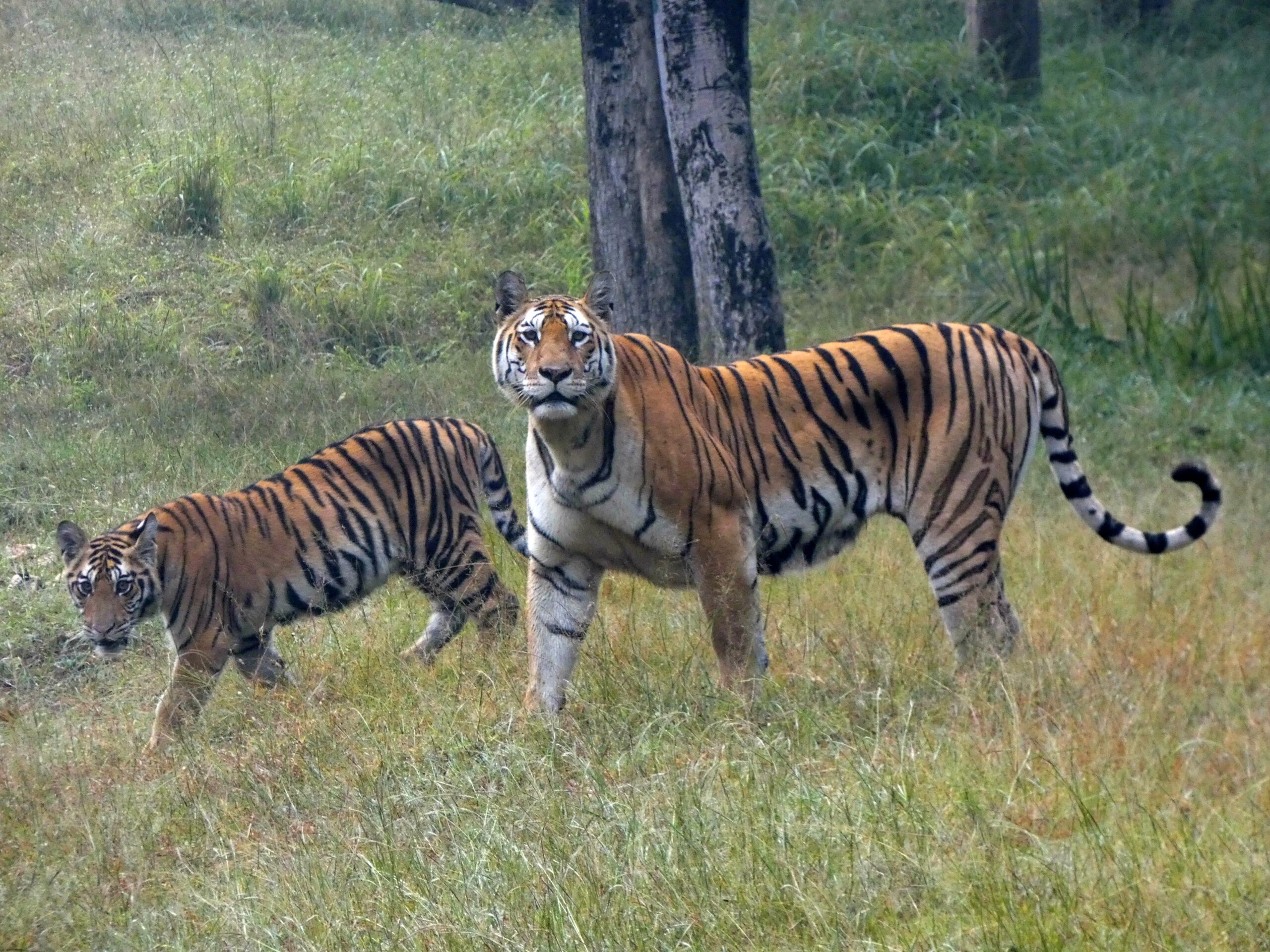
The survival of charismatic animals like the tiger, a so-called ‘apex predator’, is an indicator of a habitat’s health but, more than that, it is a test of humanity’s ability to transition and live in harmony with the biosphere. Globally we are living through a mass extinction event, but over the past 12 years, the number of wild Bengal Tigers in Nepal has nearly tripled, according to the latest National Tiger and Prey Survey. There are now 355 individual wild tigers in Nepal – a 190 percent increase since 2009. Their experience reveals both the challenges and possibilities of rapid species revival.
Nepal’s success in enabling wild tiger populations to recover is part of a wider global push to boost wild tiger populations. According to the International Union for Conservation of Nature (IUCN), there are at least 40 percent more tigers in the wild than there were in 2015. Although tigers are still endangered, and face multiple threats, the recovery shows that, in the words of Dr Roríguez of the IUCN Species Survival, “solving complex conservation challenges is possible and within our reach”.

Nepal’s successes is evidence of how a mixture of conservation policies, from establishing protected areas and opening up cross-border wildlife corridors, to engaging with the surrounding communities and cracking down on poaching, can deliver rapid results and inform broader transitions across society to bring local economies in harmony with the biosphere.
Yet there is still room for improvement in Nepal’s approach. Amnesty International reports multiple instances of forced evictions within protected areas, where Indigenous communities have been pushed off their ancestral homelands that have provided life and livelihoods for centuries.
After reaching an all-time low of 3,200 individual wild tigers in 2010 due to factors ranging from illegal poaching to the degradation and destruction of their habitats, estimates put the global population somewhere in the region of between 3,726 and 5,578 wild tigers. Such a rapid rate of recovery for a large carnivore is hugely impressive and promising for future conservation efforts. However, there is still a lot more to be done to return the wild tiger population to its former glory, as a century ago there were around 100,000 in the wild.
The recovery of wild tiger populations has undoubtedly been an international success story – with countries like Nepal at its heart. Although the populations of wild tigers are nowhere near the heights they were a century ago, their numbers have been increasing and, crucially, their populations have been stabilising. This is not only good news for wild tigers themselves, but for the ecosystems they inhabit.
As large apex predators, wild tigers are considered keystone species, playing a vital role in maintaining and shaping the health and diversity of the ecosystems they are part of. For instance, wild tigers have been shown to prevent overgrazing and habitat degradation by hunting herbivores, such as deer. Wild tigers also help distribute seeds and nutrients around their habitats through their movements and predation activities. What’s more, the presence of wild tigers can help increase the number of other species within a given ecosystem, such as birds and small mammals. This is due to wild tigers creating a “landscape of fear”, where their presence deters other potential predators entering certain areas, giving rise to great habitat specialisation and diversity. Other wild animals, such as wolves and wild boar, also create these landscapes of fear.
Bringing back big cats, however, is not without controversy and challenges. Some conservation programmes around the world have adopted ‘shoot-to-kill’ policies in the face of apprehending poachers. In places like India and across the African continent in Botswana and the Congo, trigger-happy rangers have killed poachers with the full support of the law and in the name of conservation.

This, which is often described as a ‘necessary evil’, has fuelled lively debates around animal rights being put ahead of human rights. Many have argued that ‘shoot-to-kill’ policies are not only immoral but also offer only a temporary deterrent, as rangers are unable to interact and eventually understand the social and economic drivers for illegal poaching, which are often far-removed from where the poaching takes place. The violence also flows both ways, with many park rangers being attacked or killed when protecting endangered species such as rhino. Nepal does not have a shoot-to-kill policy.
As wild tiger populations grow and human encroachment on habitats continues, they undoubtedly come into more regular contact with people and human settlements. This has led to an increase in the number of wild tiger attacks on humans, with 104 tiger attacks recorded over the last three years within protected areas in Nepal. These attacks have caused the deaths of 62 people in Nepal and, out of all the attacks, 28 percent resulted in severe injuries. As the wild tiger population stabilises, Nepal is at a crucial juncture where humans and tigers must adapt to co-existence, which could provide insights and lessons for other large animals conservation projects.
Nepal’s successes are due, in part, to the Global Tiger Recovery Program (GTRP), a global initiative launched by the World Bank and Global Tiger Initiative (GTI) in 2010. GTRP is a partnership of governments, international organisations, and NGOs all working towards the goal of doubling the number of tigers in the wild by 2022 – the Lunar Year of the Tiger. While the programme is framed as global, its focus is the 13 ‘tiger-range’ countries: Bangladesh, Bhutan, Cambodia, China, India, Indonesia, Lao PDR, Malaysia, Myanmar, Nepal, Russia, Thailand, and Viet Nam.
The GTRP deploys a variety of conservation methods and seeks to find solutions to the specific challenges facing wild tigers in a given country, rather than applying a one-size-fits-all approach. The conservation methods used range from protected area management and the establishment of new national parks and reserves, to anti-poaching measures and habitat restoration. Nepal has made use of all these methods to drive its rapid recovery of wild tigers – and it isn’t alone, with similar successes recorded in China, Russia, and Bhutan.

But conservation projects are never straightforward and there are inevitable trade offs and compromises that can, in turn, reproduce unjust outcomes. In practice, conservation policies that target species like tigers often get a lot of attention due to the iconic status these animals enjoy across a variety of cultures and in popular media and art. Images and mythologies that surround tigers have inspired stories for generations. At times, this has drawn criticism that such initiatives are undermined by ‘speciesism’ – that is, these projects have a tendency to focus on the most iconic and recognisable species in order to bolster funding, attention, and political buy-in.
Sometimes these projects have come at the cost of other species, the ecosystem as a whole, and the communities that live alongside wild animals. Projects like these brush over the scale of multispecies entanglements, furthering false dichotomies of native and invasive species, while disregarding the lived experiences of communities that have lived alongside wild animals harmoniously for centuries.
Conserving nature is a complex challenge and there is no single solution. Much like a healthy ecosystem, a project’s success is the result of many moving parts, working in tandem, towards a shared goal. Nepal’s achievements in bringing back their wild cats personifies this mix of methods.
Over the past twelve years, Nepal has established a number of protected areas where wild tigers can roam freely. New national parks and wildlife reserves have popped up across the country, with some, such as Bardia National Park and Khata Forest Corridor receiving Conservation Excellence Awards. In Nepal, a country that is slightly larger than the US state of Arkansas, there are approximately twelve national parks, one wildlife reserve, six conservation areas, and one hunting reserve. Approximately 20 percent of its land has protected status, giving Nepal the moniker as the “Amazon of Asia”. However, much more is needed to respect and protect Indigenous communities’ ancestral lands.
Nepal has implemented a strict anti-poaching policy to deter poaching of tigers and other endangered or protected species. As part of this policy, the Nepalese government provides training and resources to law enforcement agencies, as well as working with local communities to inform them of the importance of conservation and the dangers of poaching. Since implementing these measures, Nepal has recorded “zero poaching” over four consecutive years in its national parks, against a backdrop of growing trade in the illegal wildlife trade that is worth £17bn a year globally.
Other conservation methods implemented in Nepal include breeding tigers in captivity and then releasing them into the wild and habitat restoration in order to reverse environmental degradation to establish more suitable habitats for big cats, which included the construction of large lakes to act as oases for wildlife.
For a country like Nepal, cross-border collaboration is unavoidable. Sandwiched between China to its north, and India to the south, it is a land-locked country whose ecosystems and wildlife pay no heed to man-made concepts like borders. Alongside the Global Tiger Recovery Program (GTRP), which is an inherently collaborative initiative, Nepal has worked with its neighbours to create protected wildlife corridors that allows tigers and other creatures to move freely during mating season and to avoid monsoons. After all, nature does not recognise human concepts of borders that often cause problems for wildlife.

The Khata Corridor is a 15-mile pathway that connects Nepal’s Bardia National Park with India’s Katarniaghat Wildlife Sanctuary. While the Khata Corridor is a relatively small wildlife corridor, its biodiversity punches well above its weight. Just twenty years ago, the Khata Forest was a degraded landscape, devoid of life, but now it is bursting with flora and home to tigers, rhinos, spotted deer, and grey langur monkeys. Many other cross-border wildlife corridors are in the initial planning stage, with the Green Economic Corridor (GEC) between China and Nepal beginning to gather pace. Nature restoration and conservation are an essential part of this project.
Any successful conservation project requires genuine community buy-in. Engaging surrounding communities on the necessity of conservation and providing alternative sources of income to reduce resource extraction from protected areas has been shown to reduce the drivers of environmental degradation. The necessity of extractive industries and economies to perpetually expand and consume is one of the major drivers of biodiversity loss. Working with communities to collaboratively create more sustainable forms of income is therefore vital.
Nepali community conservation efforts have been successful throughout the country by helping citizens meet their needs without infringing on key biodiversity hotspots. One notable success story is from the community living on the edge of the Suklaphanta National Park in the West of Nepal. As a community that is deeply dependent on its livestock, in particular cows, herders were often taking their livestock into the national park to graze, despite the risk of being fine or – worse still – attacked by a tiger. Overgrazing had a huge impact on the food chain within the park that directly affected the wild tigers.
To solve this growing issue, the Zoological Society of London (ZSL) provided funding and training to the herders to help them set up a dairy co-operative, which has now grown to 100 members. ZSL also introduced a different breed of cows to the dairy farmers that produced more milk than native Nepali cows, which meant the herd sizes and required grazing pastures could be reduced without infringing on the villages sustenance or income.
While there have been notable success stories in Nepal’s conservation push, large sections of society have been completely disregarded and, at times, state violence has prioritised popular wildlife and tourism over its citizens. Nepal’s Indigenous communities have been the largest victims of the conservation successes, with many forced from their ancestral lands and livelihoods, while some have been arrested and killed. Despite Indigenous communities having their rights codified in Nepal’s constitution, ill-treatment and forced evictions have entrenched cycles of poverty and exclusion that have severely impacted their way of life. For Nepal to be held up as a true global leader in conservation, much more needs to be done to improve the rights of those that have lived on the land, side-by-side with wildlife, for centuries.